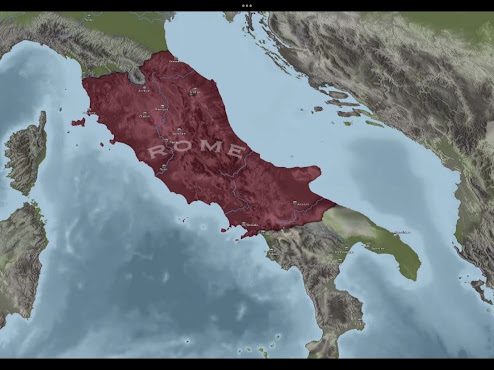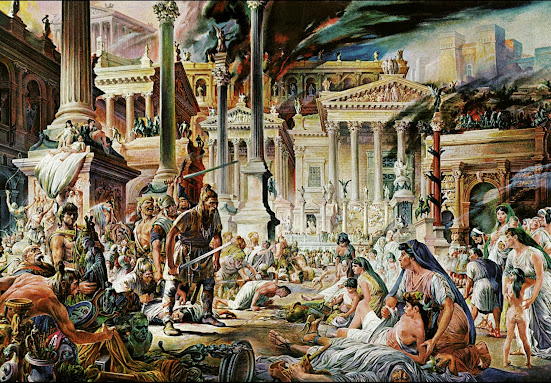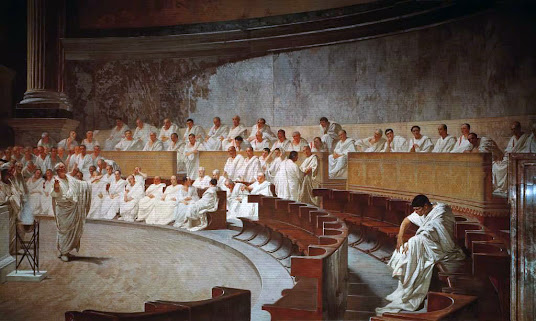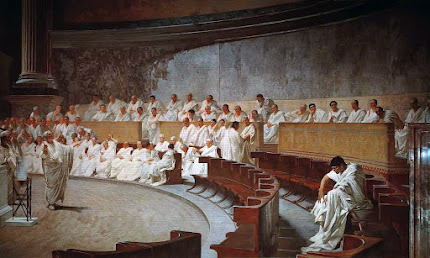The Punic wars
The Punic wars occurred between the Roman Republic and the Carthaginian empire between 264-146 B.C. Carthage was a trade centric city in North Africa, modern day Tunisia. The origin of Carthage goes back to Phoenician civilisation which flourished in the Levant in the Middle East. The Phoenicians set up many colonies on the Mediterranean coast, one of them was Carthage in 814 B.C. The Carthaginians were famous for their strong navy which made them taking control over western Sicily, Sardinia, Corsica and southern Spain. The tensions began brewing between Rome and Carthage in the beginning of the third century B.C, when both empires wanted to control the Mediterranean Sea and its island such as Sicily and Sardinia.
The Punic wars are divided into three wars, the first, the second and lastly the third.
Rome
Carthage
The first Punic war
The expansion of the Carthaginian empire in the Mediterranean basin worried the Greek empire, as there were many greek colonies in eastern Sicily threatened by Carthaginian invasions. Aganognes, the greek king of Syracuse in eastern Sicily, in his war agains Carthage hired some of Italian mercenaries called “Maemertines “ to help him fighting the Carthaginians. After his death, the Maemertines attacked the city of Messina in the north of the island. The new king of Syracuse, Heirro the second was disgruntled about them, so he planned to retake the city. The Maemertines sent tow delegation, one to Carthage and another to Rome seeking help against Heirro. Carthage responded first because they see it a good opportunity to make pressure on the Greeks in the island. After knowing that Carthaginians reached Messina, Heirro retreat to Syracuse. Then, the Carthaginians declared that they are ruling now on Messina, this situations displeased the Maemertines, so they sent a delegation to Rome seeking assistance. The Roman senators saw it a great opportunity to interfere in Sicily. So, Rome had sent its legions under the command of Appius Claudius Caecus to Messina. The Romans assisted by the Maemertines had driven the Carthaginians out of the city. The Carthaginians were not idle, they sought help from the greek king of Syracuse. Indeed, the Carthaginians assisted by the Greeks marched to Messina and besieged it. A few days later, the Roman commander, Appius Claudius led the legions to the city to fight the Carthaginian-Greek coalition and managed to defeat them. A year later, Rome sent its tow councils, Marcus Aurelius and Manus, with 40000 troops to complete the Campaign in Sicily.
Carthage responded by sending troops to Sicily in order to consolidate its position in the island. Then, the first Punic war had begun.
The Roman troop reached Sicily and conquered all the towns between Messina and Syracuse, then besieged Syracuse, but they faced a problem, there are no enough resources to feed such a huge army, in addition, the Carthaginians surrounded the island from all sides to cut off the supply lines. The situation was glooming, but something unexpected happened, the king of Syracuse signed a peace treaty with the Romans pledging to pay tribute to Rome and provide supply to its troops in exchange for remaining in ruling of the city. In 262 B.C, Rome sent the same number of troops to Sicily under the command of the new tow councils, Lucius and Quintus Mamilius to invade the city of Agragas which was under Carthage’s rule. The Carthaginian governor of the city, Hannibal Disco, decided to force people to get into the city. The Roman councils decided to dig a ditch around the city and besiege it. After 5 months of siege, Hannibal Disco resized the real danger and decided to seek help from Carthage. Carthage responded by sending a huge army estimated at 50000 soldier and 50 elephants under the command of Hanno. In the beginning of the battle the Carthaginians inflected heavy losses to the Romans, but the Roman troops restored balance and counterattacked the Carthaginians making them suffer huge losses. Both sides suffered disastrous losses and no one is victorious. But the lack of food caused the Carthaginians troops to retreat and abandon the city.
After invasion of Agragas, the Carthaginians sent a lot of ships to Sicily in order to protect her colonies in the island. The Romans realised that they have no chance to defeat Carthage unless they have a strong fleet. Unfortunately Rome didn’t have a fleet, as the Romans were known for their might in land not in sea in contrast to Carthage which were renounced for its strong fleet. But fortune smiled on Romans when they captured a Carthaginian ship and found on it a paper teach how to manufacture a ship like this. In 260 B.C Rome made 120 war ships to turn the tide against Carthage. In the same year the Roman senate elected tow councils, Genius Cornelius Scipio who was selected to lead the army on sea and Gaius Toluis who was selected to lead the army on land. News reached the Roman army that a rebellion occurred in the island of Lipari to the north of Sicily which courage the Roman fleet of 14 ships to invade the island and take control of it. It was the first naval victory in history of Rome. Having learned about the invasion of the small island, Hannibal Gisco decided to take 17 ships and set sail to the conquered island to recapture it. Under the cover of darkness, he attacked the 14 ships which was on the coast of the island and seized it spreading terror among the Roman soldiers, in addition to arrest of the Roman council, Scipio. After the Arrest of Scipio Rome assigned Toluis as a commander of both sea and land army. Toluis sailed to confront the Carthaginians fleet under the command of Hannibal Gisco in the battle of Miely 260 B.C.
The Carthaginians fleet consisted of 130 ships, while the Roman fleet, heavily outnumbered, consisted of 103 ships. Knowing their outnumbered army and lack of experience in sea war in comparison to Carthage, the Romans invented a ladder-like thing thrown into the enemy’s ships enabling the Roman soldiers to get into the ships, and killing the enemy’s soldiers. This invention turned the tide of war, leading to destruction of the 20 ships of the Carthaginian fleet and Rome’s victory in the battle of Miely. Shocked by the defeat, the Carthaginian senate sent more ships under the command of Hamilcar Barca, the father of Hannibal Barca the legendary hero of the second Punic war, to prevent Rome’s from invasion of more cities in Sicily. In 259 B.C, Hamilcar Barca was able to defeat the Romans in the battle of Thermae. Short after, he marched to the city of Enna and Karmina and took control of them. One year later, Rome sent a great army to Sicily succeeding in reconquest of Enna and Karmina in addition to conquest of the city of Metacitratone in the center of the island. The war continued back and forth for tow years to come, this led to discontent of the Roman senate, as a result, Rome mustered a greatest fleet in all of its history in 256 B.C with 330 ships and 140000 soldiers to invade Carthage itself. The huge fleet was under the command of the new tow councils, Lucius Manlius Vulso Longus and Marcus Atilius Regulus, having learned the news of upcoming invasion, Carthage decided to prepare a huge fleet with 350 ships and 150000 soldiers under the command of Hamilcar Barca. The Romans and the Carthaginians fought each other in the battle of Ecnomus, which is known as the greatest naval battle in history. Despite the Hamilcar’s elaborate plan of feint retreat, the Romans was able to win the battle. 30 Carthaginians’ ships were destroyed, 64 captured and 30-40 thousands were killed or captured, while the Roman losses were much lighter, as 24 ships were destroyed with 10000 men killed in the battle. Following the disastrous battle of Ecnomus, the Roman fleet under the command of Regulus headed to Carthage to destroy it once and for all.
Wait the coming episode to know what happened next in the first Punic war
Demonstration of battle of Ecnomus 256 B.C





















